What to See in Jaisalmer: Hidden Gems + Top Attractions Guide
Imagine stepping into a living fairy tale where golden sandstone walls tell centuries-old stories, and the vast Thar Desert stretches endlessly under brilliant blue skies. Welcome to Jaisalmer, Rajasthan’s crown jewel that rises from the desert like a magnificent mirage. This isn’t just another tourist destination—it’s a place where history breathes through every carved stone, where camel bells echo ancient trade routes, and where sunsets paint the entire city in molten gold.
Whether you’re wondering what to see in Jaisalmer for your first visit or seeking those secret spots that most travelers miss, this guide reveals both the iconic landmarks and the hidden corners that make this Golden City truly magical. From exploring the world’s last living fort to sleeping under a million desert stars, we’ll show you how to experience Jaisalmer like a true explorer, not just a tourist.
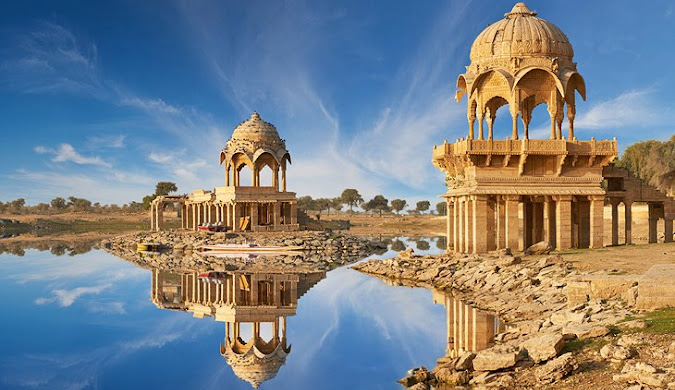
Quick Reference Table
| Category | Key Information | Best Time | Duration |
| Fort & Havelis | Jaisalmer Fort, Patwon Ki Haveli | Early morning (7-9 AM) | 4-5 hours |
| Desert Experience | Sam Sand Dunes, Khuri Village | Sunset (5-7 PM) | Overnight recommended |
| Cultural Sites | Jain Temples, Bada Bagh | Morning/Evening | 2-3 hours each |
| Hidden Gems | Kuldhara Village, Khaba Fort | Late afternoon | 2-4 hours |
| Best Season | October to March | Cool weather | 2-4 days ideal |
| Border Areas | Tanot Temple, Longewala | Full day trip | 8-10 hours (permit required) |
What Makes Jaisalmer Special: The Golden City’s Unique Charm
The Golden Phenomenon
Jaisalmer’s golden hue isn’t just a poetic description—it’s a daily miracle. Built entirely from yellow sandstone, the city literally glows like burnished gold, especially during sunrise and sunset. This unique limestone, quarried locally, contains iron oxide that creates the warm, honey-colored appearance that has mesmerized travelers for centuries.

Desert Location & Climate
Positioned in the heart of the Thar Desert, Jaisalmer sits just 120 kilometers from the Pakistan border. The desert climate means scorching days (often reaching 45°C in summer) and surprisingly cool nights. The best time to visit Jaisalmer is definitely October through March, when temperatures hover around a comfortable 20-25°C during the day.
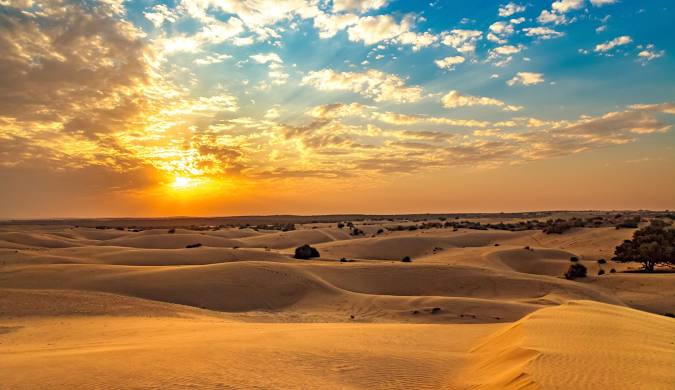
A Glimpse into History
In 1156 AD, Rawal Jaisal, a Rajput ruler, founded this city after receiving a prophecy from a hermit. The location was strategic—positioned along ancient camel-train trade routes connecting India with Central Asia and the Mediterranean. For centuries, wealthy merchants built elaborate havelis (mansions) with their trade profits, creating the architectural wonderland we see today.
The Must-See Icons: Beyond the Ordinary Tourist Trail
Jaisalmer Fort (Sonar Qila): The Living Fortress
Unlike most Indian forts that stand empty as monuments, Jaisalmer Fort pulses with life. Nearly 4,000 people still live within its massive walls, making it one of the world’s few living forts. As you climb through the fort’s narrow lanes, you’ll hear children playing, smell fresh chapatis cooking, and see women hanging colorful sarees from ancient balconies.
Insider Tips for Your Visit:
- Start your Jaisalmer sightseeing early (7 AM) to avoid crowds and heat
- Visit Café the Kaku inside the fort for stunning panoramic views with your morning chai
- Explore the back lanes near the Laxminath Temple where local families welcome curious visitors
- The fort walls offer the best sunrise photography spots—ask any shopkeeper for directions to the “secret viewpoint”
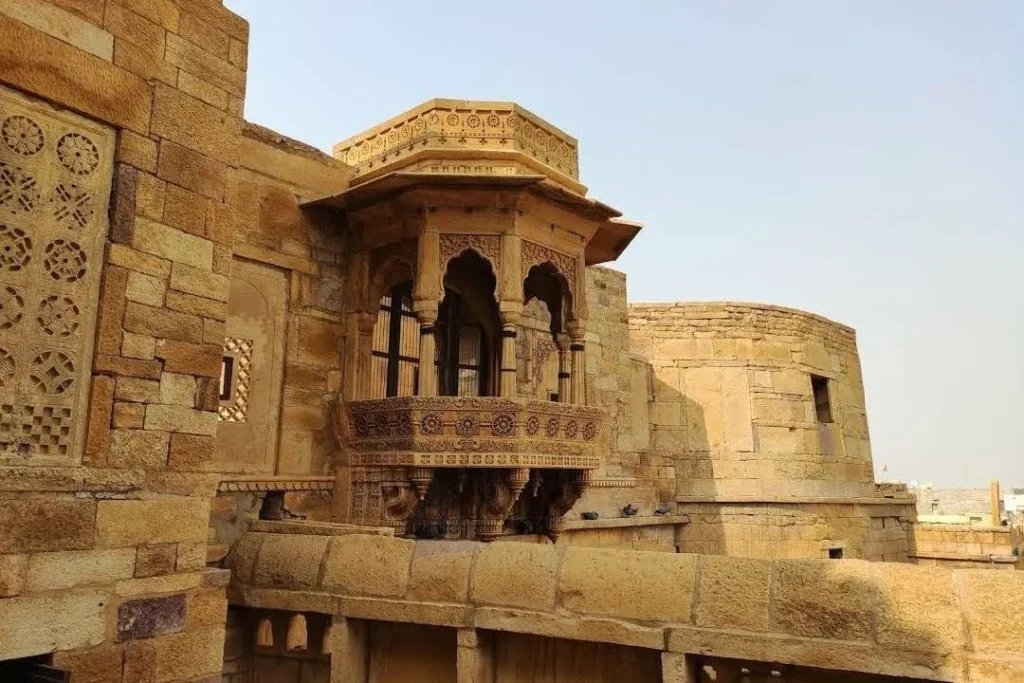
Jain Temples: Architectural Poetry in Stone
Hidden within the fort complex, these 12th-century temples showcase incredible Dilwara-style architecture. The intricate marble carvings are so detailed that some pillars appear transparent when backlit. The Parsavanath Temple features over 600 divine figures, each uniquely carved.
Photography Pro-Tip: Visit between 11 AM-12 PM when soft sunlight filters through the carved screens, creating magical light patterns on the marble floors.
The Grand Havelis: Merchant Palaces with Stories
Patwon Ki Haveli
This cluster of five havelis took 50 years to complete. The Guman Chand Patwa, a wealthy trader, built the first one for his son, then kept adding more for each family member. The intricate jharokhas (balconies) feature over 60 different balcony designs—no two are identical.
Nathmal Ki Haveli
Here’s a fascinating story: Two brothers built the left and right sides simultaneously without coordinating their designs. The result? A beautifully asymmetrical haveli where each side reflects different artistic interpretations of the same architectural brief.
Salim Singh Ki Haveli
The prime minister’s residence features a distinctive peacock-shaped roof and 38 balconies. Local legend says Salim Singh planned to connect his haveli to the fort with a bridge, but the Maharaja stopped construction, fearing it would overshadow the royal palace.
Best Photography Time: Visit Patwon Ki Haveli between 4-6 PM when the golden hour light enhances the intricate stone carvings.
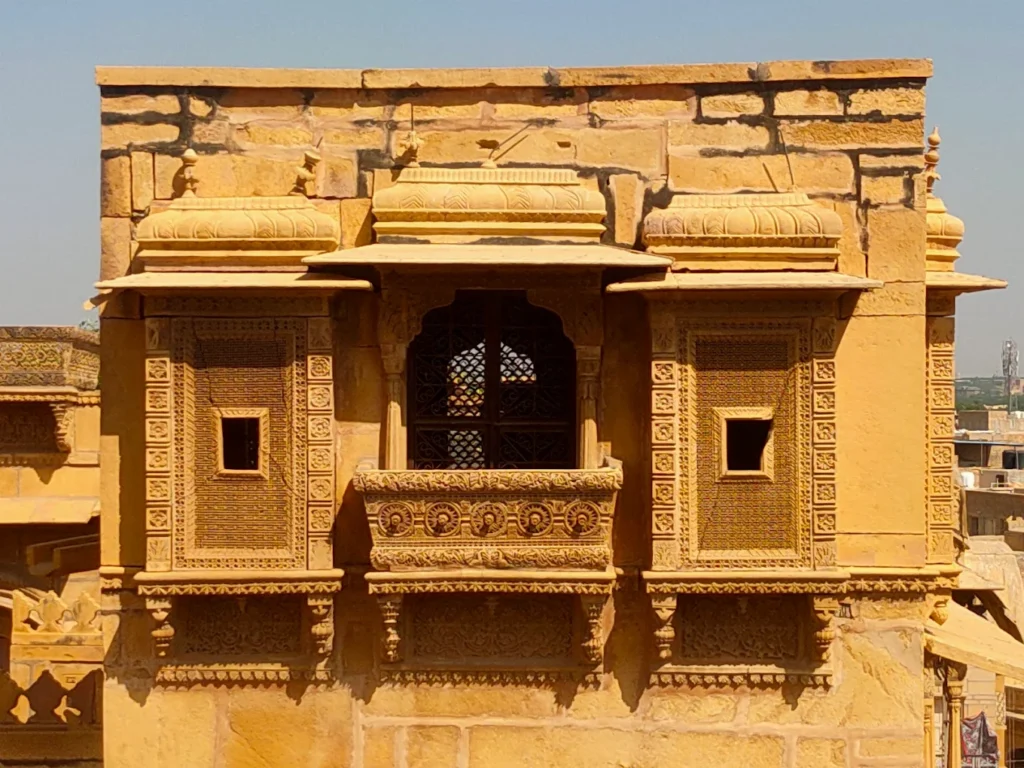
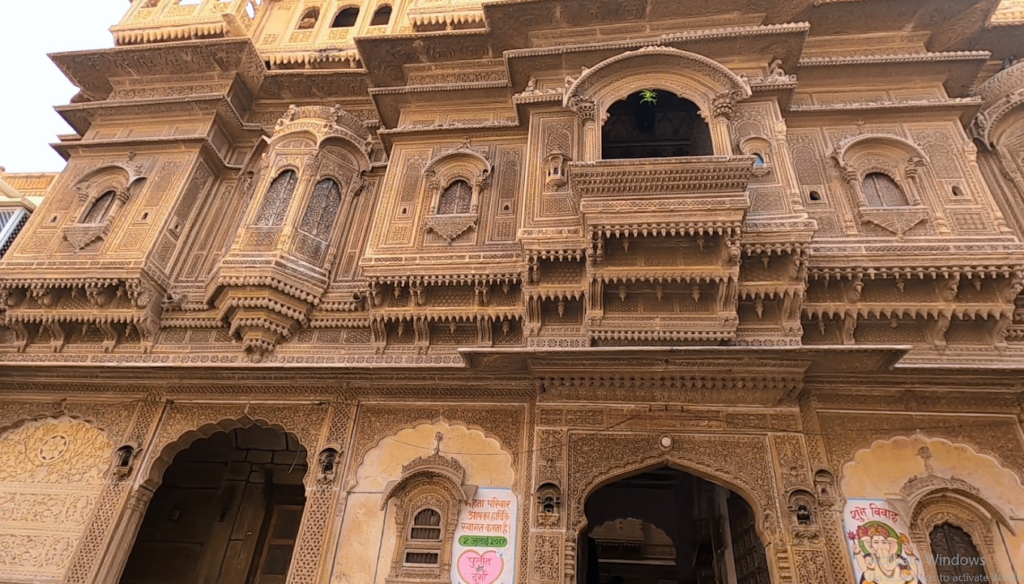
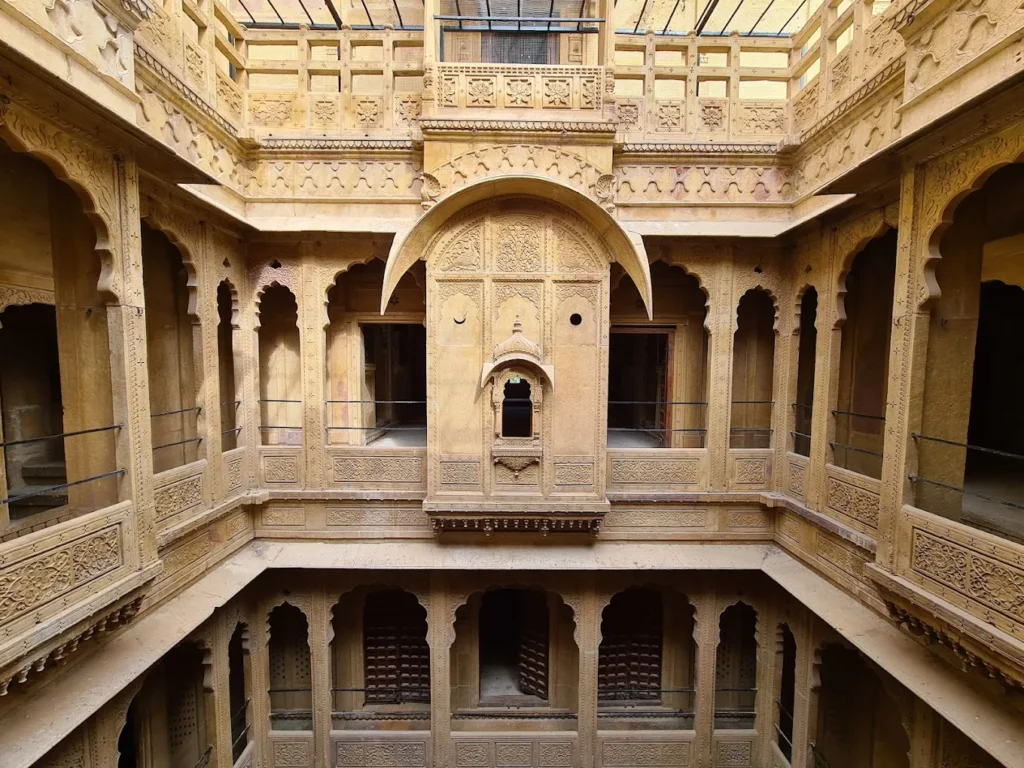
Bada Bagh & Vyas Chhatri: Royal Monuments in Desert Landscape
These aren’t tombs but chhatris (cenotaphs)—symbolic monuments honoring deceased rulers. Bada Bagh contains cenotaphs of Jaisalmer’s Maharajas, while Vyas Chhatri commemorates the royal sage Vyas.
Golden Hour Magic: Arrive 30 minutes before sunset. As the sun dips, these monuments create dramatic silhouettes against the orange-pink sky, making them a photographer’s dream location.
Desert & Nature Experiences: Beyond the Sand Dunes
Sam Sand Dunes vs. Khuri Village: Choosing Your Desert Adventure
Sam Sand Dunes
The more popular choice, Sam offers organized desert safari Jaisalmer experiences with camel rides, cultural programs, and camp stays. However, expect crowds, especially during peak season.
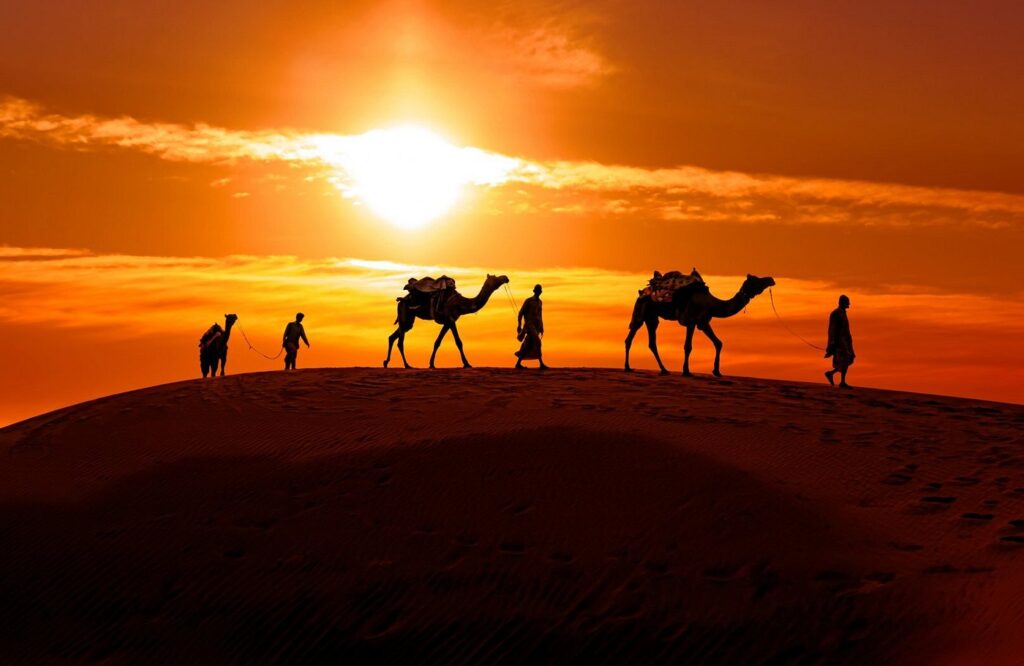
Khuri Village
Located 40 km southwest, Khuri provides a more authentic desert experience. The dunes are smaller but the atmosphere is quieter, with better opportunities to interact with local Bishnoi families and witness traditional desert life.
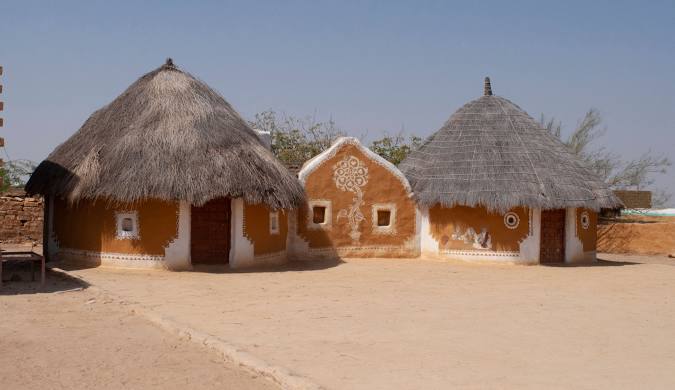
Camp Selection Tips:
- Look for camps offering organic local cuisine and traditional music performances
- Ensure clean restroom facilities and comfortable bedding
- Avoid overcrowded camps—smaller operations often provide more personalized experiences
- Book directly with camp operators for better rates and service
Desert National Park: Wildlife in the Wilderness
Spread across 3,162 square kilometers, this park protects the endangered Great Indian Bustard. Only about 100-150 birds remain worldwide, making sightings extremely rare and precious. You’ll also spot desert foxes, chinkaras (Indian gazelles), and various raptor species.
Best Safari Strategy: Early morning safaris (6-8 AM) offer the highest wildlife spotting chances when animals are most active.
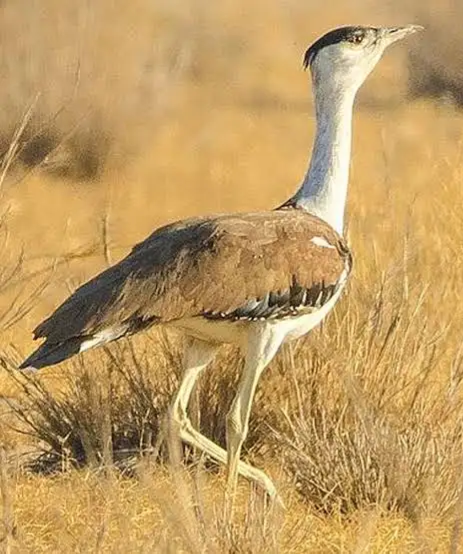
Akal Wood Fossil Park: Journey Back 180 Million Years
This unique site showcases fossilized tree trunks from the Jurassic era. These ancient trees, now turned to stone, provide fascinating insights into when this desert region was actually a lush forest. The largest fossil measures over 13 meters long and 1.5 meters in diameter.
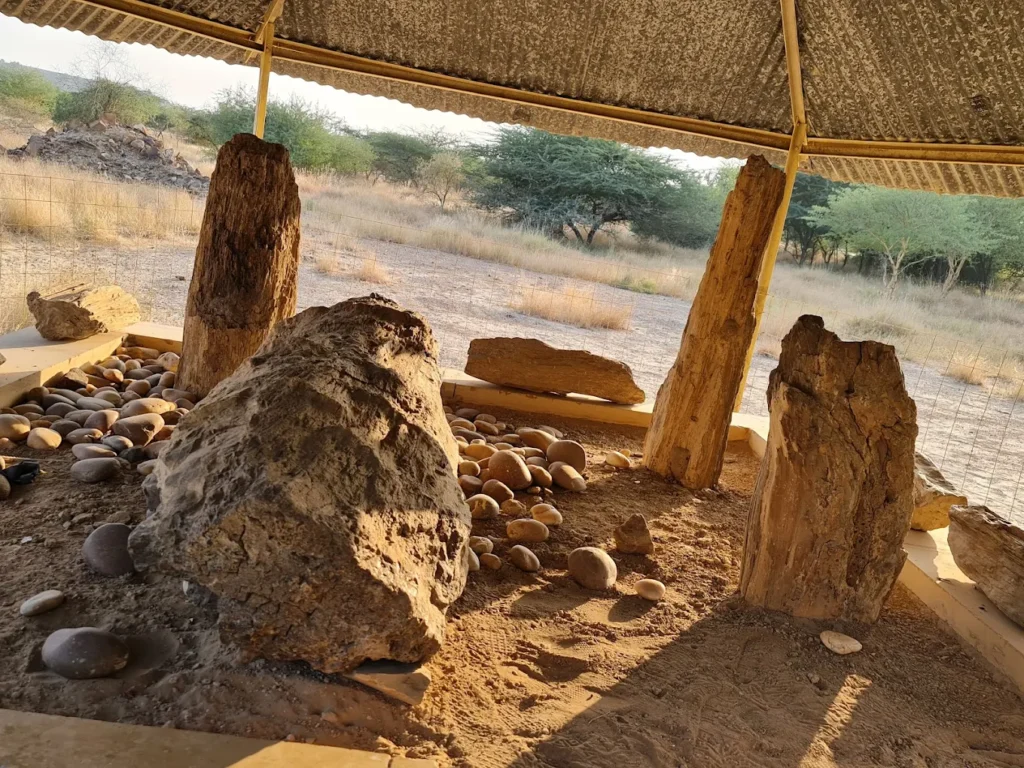
Windmill Park: Where Ancient Desert Meets Modern Energy
The contrast is striking—hundreds of modern wind turbines spinning against the backdrop of ancient sand dunes. This renewable energy project generates clean electricity while creating an unexpectedly beautiful landscape perfect for unconventional photography.
Mystical & Border Attractions: Stories and Legends
Kuldhara Village: The Mystery of the Abandoned Settlement
The legend claims that 1,500 people vanished overnight in 1825, cursing the land so no one could ever resettle here. Local stories blame an evil minister’s demands, but archaeological evidence suggests a more practical reason: water scarcity and economic decline due to changing trade routes.
What You’ll Find Today:
- Well-preserved house foundations and street layouts
- Archaeological markers explaining the village’s actual history
- Interpretive center separating myth from historical facts
- Sunset views over the abandoned settlement creating an eerie, beautiful atmosphere
Tanot Mata Temple & Longewala: Faith and Patriotism
Tanot Mata Temple
During the 1965 Indo-Pak War, Pakistani forces dropped 3,000 bombs near this temple—not one exploded. Locals attribute this miracle to Mata Tanot’s protection. The temple now displays unexploded bombs as testament to divine intervention.
Longewala Border Post
The site of the famous 1971 war battle where 120 Indian soldiers held off 2,000 Pakistani troops with 45 tanks. The Longewala War Memorial showcases actual tanks and aircraft used in the battle.
Important: Border area permits are required. Apply at the District Collector’s office in Jaisalmer or online through the Rajasthan Tourism website. Carry original ID proofs and respect all military protocols.
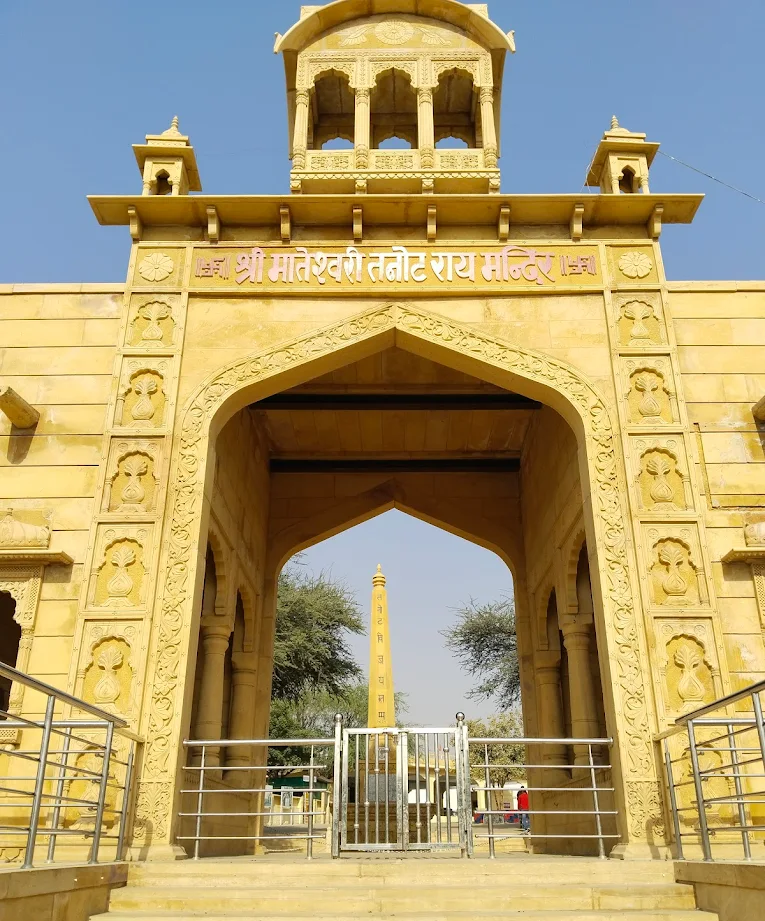
Jaisalmer War Museum: Honoring Heroes
This military museum, managed by the Indian Army, showcases the Battle of Longewala through displays of captured Pakistani tanks, vintage aircraft, and soldier testimonials. The museum effectively combines military history with patriotic inspiration.
Hidden Gems & Lesser-Known Spots
Offbeat Attractions Worth Exploring
Khaba Fort
This abandoned 13th-century fort offers panoramic desert views without crowds. The ruins create an atmospheric exploration experience, especially during late afternoon when golden light illuminates the ancient stones.
Local Markets Beyond Tourist Shopping
- Sadar Bazaar: Authentic leather mojaris (traditional shoes) and camel leather products
- Pansari Bazaar: Mirror work textiles, silver jewelry, and locally-made crafts
- Bhatia Bazaar: Antique dealers selling genuine vintage items and tribal artifacts
Shopping Strategy: Visit local markets in early morning or late evening when shopkeepers are more relaxed and willing to share stories about their crafts.
Cultural Learning Centers
- Thar Heritage Museum: Private collection showcasing folk instruments, traditional weapons, and desert lifestyle artifacts
- Desert Culture Center: Live demonstrations of traditional crafts including block printing, mirror work, and camel leather processing
Local Life, Culture & Gastronomy
Authentic Jaisalmer Flavors
Must-Try Local Dishes:
- Ker Sangri: Desert beans and berries curry—a unique Rajasthani delicacy unavailable elsewhere
- Dal Baati Churma: Lentil curry with baked wheat balls and sweet crushed wheat
- Gatte ki Sabzi: Gram flour dumplings in spicy gravy
- Makhania Lassi: Saffron-flavored yogurt drink perfect for desert heat
Where to Experience Authentic Flavors:
- Trio Restaurant (inside the fort): Rooftop dining with fort views
- Natraj Restaurant: Local family-run establishment serving traditional recipes
- Desert Boy’s Dhani: Village-style dining on floor seating with cultural performances
Cultural Immersion Opportunities
Jaisalmer Desert Festival (February)
A three-day celebration featuring camel races, folk music competitions, turban-tying contests, and traditional dance performances. The highlight is the fire dancing and acrobatic performances under desert stars.
Folk Entertainment
- Manganiyar and Langa musicians perform traditional Rajasthani folk songs
- Puppet shows at local cafes showcase ancient storytelling traditions
- Heritage walks with local guides reveal family histories and neighborhood legends
Practical Visiting Guide & Essential Tips
Best Time to Visit Jaisalmer
| Season | Months | Temperature | Pros | Cons |
| Winter | Oct-Mar | 10-25°C | Perfect weather, clear skies | Peak season crowds |
| Summer | Apr-Jun | 35-45°C | Fewer tourists, lower prices | Extreme heat |
| Monsoon | Jul-Sep | 25-35°C | Green landscapes, cool evenings | Unpredictable rainfall |
Suggested Itineraries
2-Day Whirlwind Trip:
- Day 1: Jaisalmer Fort, Jain Temples, Patwon Ki Haveli, sunset at Vyas Chhatri
- Day 2: Morning heritage walk, Sam Sand Dunes afternoon desert safari with overnight camping
3-Day Explorer Experience:
- Add Kuldhara Village, Bada Bagh, Desert National Park, and Tanot Mata Temple day trip
- Include cultural performances, local market exploration, and cooking class experiences
4-Day Complete Discovery:
- Include all above plus Khuri Village, Akal Fossil Park, border area exploration, and relaxed fort exploration
Transportation & Logistics
Reaching Jaisalmer:
- By Train: Direct trains from Delhi (12 hours), Jodhpur (5 hours), Jaipur (12 hours)
- By Air: Fly to Jodhpur Airport (285 km away), then cab (4-5 hours) or bus
- By Road: Well-connected state highways from major Rajasthan cities
Local Transportation:
- Auto-rickshaws: ₹10-15 per km for city sightseeing
- Bicycle rental: ₹100-150 per day—perfect for fort exploration
- Motorcycle rental: ₹300-500 per day for desert excursions
- Private car: ₹2000-3000 per day with driver
Essential Packing & Safety Tips
Desert Survival Essentials:
- Cotton clothing in light colors
- Wide-brimmed hat and quality sunglasses
- SPF 50+ sunscreen and moisturizing lotion
- Reusable water bottle—drink 3-4 liters daily
- Electrolyte tablets for desert activities
Cultural Sensitivity:
- Dress modestly, especially in religious sites
- Remove shoes before entering temples and homes
- Ask permission before photographing local people
- Respect military restrictions near border areas
Jaisalmer isn’t just a destination—it’s a journey through time, where every sandstone wall whispers ancient secrets and every sunset paints new memories. Whether you’re exploring the living fort, camping under desert stars, or discovering hidden village tales, this Golden City promises experiences that linger long after you’ve returned home.
Ready to write your own Jaisalmer adventure story? Start planning your trip and don’t forget to share your own discoveries and travel tips in the comments below. Every traveler adds a new chapter to Jaisalmer’s endless tale.
Frequently Asked Questions
Q1: How many days are enough for Jaisalmer? A: 3-4 days provide the ideal balance for experiencing major attractions, desert safari, cultural activities, and hidden gems without rushing. 2 days minimum for basic sightseeing, 5-7 days for complete exploration including border areas.
Q2: What is the best time of year to visit Jaisalmer? A: October through March offers the most comfortable weather with daytime temperatures between 20-25°C. December-January can be surprisingly cold at night (5-10°C), so pack warm clothes. Avoid April-June due to extreme heat (45°C+).
Q3: Is it safe to visit the border areas near Jaisalmer? A: Yes, border tourist circuits are safe and well-managed by Indian Army. However, you need permits obtained from the District Collector’s office or online. Always carry original ID, follow military guidelines, and avoid photography of sensitive installations.
Q4: What should I pack for a desert safari in Jaisalmer? A: Pack lightweight cotton clothes, closed shoes (sand protection), warm layers for night (desert gets cold), sunscreen SPF 50+, wide hat, sunglasses, personal water bottle, power bank, and basic first aid. Most camps provide bedding and meals.
Q5: Can I find vegetarian food easily in Jaisalmer? A: Absolutely! Jaisalmer is predominantly vegetarian due to Jain and Hindu influences. You’ll find excellent pure vegetarian restaurants, traditional Rajasthani thalis, and Jain food (no onion/garlic) easily available. International cuisines are also available in tourist areas.
References & Additional Resources
This guide references information from the following authoritative sources:
Official Government Sources:
- Rajasthan Tourism Official Website – Official state tourism portal with current information on permits, festivals, and attractions
- Archaeological Survey of India – Historical details about Jaisalmer Fort and heritage monuments
- Ministry of Defence, India – Information about war museums and border area regulations
Travel & Cultural Resources:
- India Meteorological Department – Weather patterns and best travel times for desert regions
- Lonely Planet India – Independent travel insights and practical information
- National Geographic Travel – Cultural and geographical context about Thar Desert region
Historical & Educational Sources:
- Rajasthan State Archives – Historical documents and royal genealogy information
- Indian National Trust for Art and Cultural Heritage (INTACH) – Heritage conservation and architectural details
- Wildlife Institute of India – Information about Desert National Park and Great Indian Bustard conservation
Local Authority Contacts:
- District Collector Office, Jaisalmer – For border area permits: +91-2992-252201
- Rajasthan Police Tourist Helpline – 24/7 assistance: 1363
- Railway Enquiry – Train schedules and bookings: 139
Emergency Contacts:
- Tourist Helpline Rajasthan: 1363
- Emergency Services: 112
- Jaisalmer Police Station: +91-2992-252238
Disclaimer: All information provided is based on research from credible sources and personal travel expertise. Travelers are advised to verify current conditions, permit requirements, and safety guidelines before visiting. Prices, timings, and accessibility may change without notice.
Read More Articles;
- Koundinya Wildlife Sanctuary Travel Guide 2026: Timings, Safari, Map, Reviews & Wildlife Highlights
- Kaas Plateau Travel Guide 2026: Best Time to Visit, Bloom Season, How to Reach & FAQs
- What Is the Quirimbas Archipelago Mozambique Known For? Complete Travel & Nature Guide
- Is Angola Safe to Travel in 2025? Your Essential Guide to Health, Crime, and Landmine Safety
- What Animals Live in Bale Mountains Ethiopia? Complete Wildlife Guide

I am always searching online for ideas that can help me. Thank you!
I?¦ve recently started a blog, the info you offer on this website has helped me greatly. Thanks for all of your time & work.
Thought-provoking